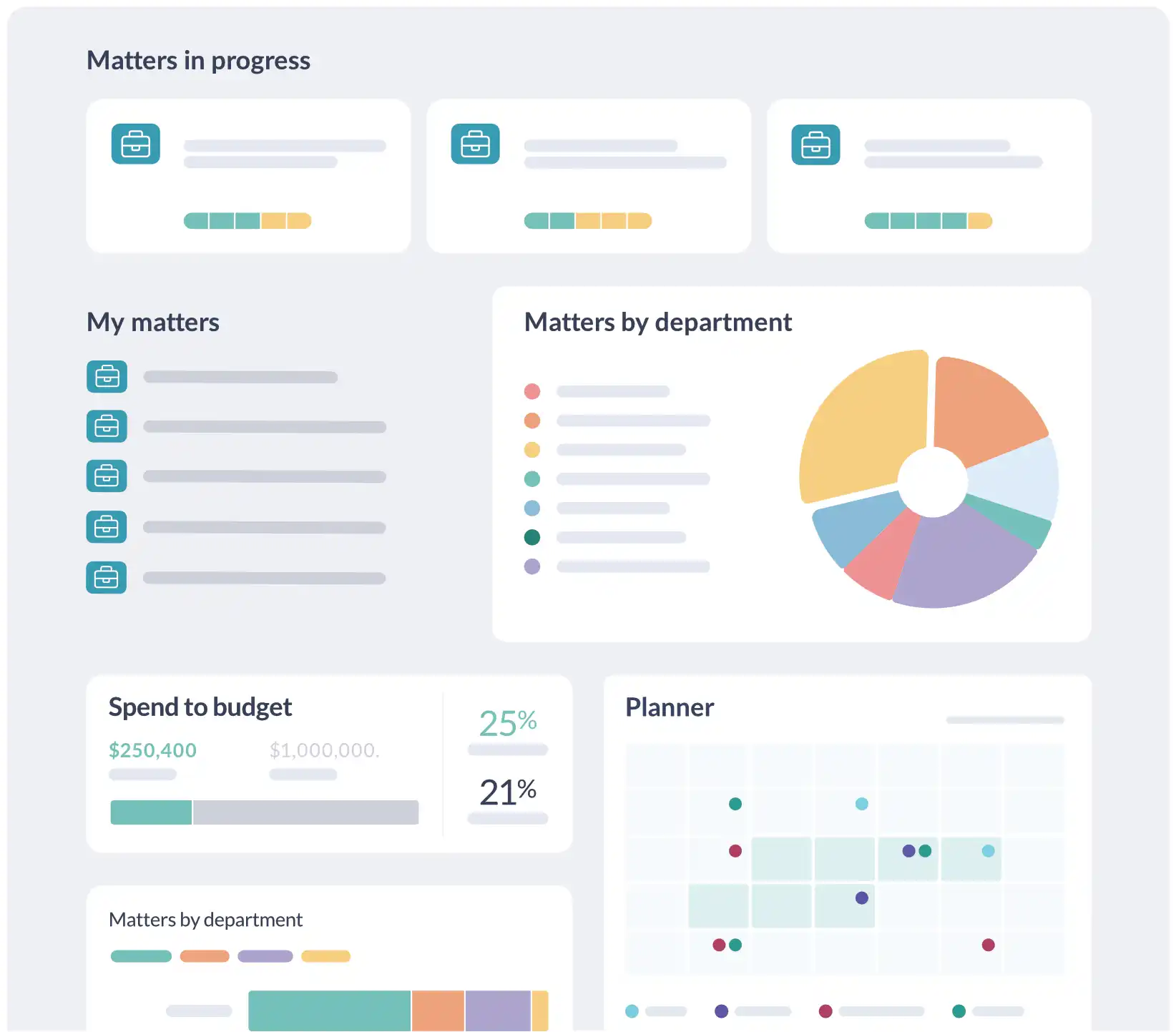Legal matter management vs case management – what’s the difference and why it matters

When it comes to legal matter management and case management software, confusion often arises as the two are spoken about synonymously. Which may make you wonder if there is a difference, and if so, what?
The answer is yes, there is a difference. And here’s a hint, when done right, there’s a strong case for one being far more effective and valuable to an in-house legal function than the other. So, with that said, let’s dive right in!
What is legal matter management?
Firstly, matter management encompasses all elements of the internal and external work raised or requested, in progress and executed within an in-house legal function. This also includes how a legal team views, engages and collaborates with each matter – whether it’s completed in-house or outsourced.
The overall goal of matter management is to support legal operations, to optimize productivity, maximize efficiency and provide visibility while mitigating risk in support of legal delivering value as a strategic business partner and enabler.
As a result, the means to manage matters, or the tools and/or technology at play is inclusive of all the cogs that keep matters in motion, starting with a business request for legal support, through to how the work is prioritized and managed, and the outcome. This is broken into:
- Intake and triage
- Planning
- Task management, collaboration and communication
- Document management
- Reporting
So, if matter management brings all the activity of an in-house legal function together in support of legal operations, where does case management software fit in the puzzle?
The difference between legal matter management and case management software
Matter management technology is distinct from case management in several ways:
- Firstly, case management is typically adopted to manage the high volume of paperwork associated with litigation – as a means to file and store the documents associated with each case – whereas matter management is specific to in-house legal functions
- Matter management and its supporting tools or technology is also far more comprehensive than case management software. It accounts for the diverse and extensive activities carried out and the oversight required by an in-house legal team, both internally and externally, as opposed to just filing and storing case-related documents, like with case management software
- Another difference is the clientele. For example, when it comes to in-house legal matters, teams typically engage two types of clientele, the business and its internal functions, and outside counsel or law firms where work is outsourced to. Case management, on the other hand, mostly supports the collaboration between attorneys and law firms working on specific cases rather than internal functions too
Now that we know some of the differences, it’s pretty clear that case management software won’t do the trick for in-house legal. However, that’s not to say all approaches to matter management will work either.
Why effective matter management matters to in-house legal
The 2025 Law Department Management Benchmarking Report (ACC) confirms that an increasing amount of legal team’s work is staying in-house. Meanwhile, automation, AI, and workflow tools are high priority for legal operations (CLOC State of the Industry Report for 2025). In other words, there is an appetite for legal functions to do more with less.
However, when it comes to legal operations and matter management we see a piecemeal approach, with 42% of teams teams utilizing four or more software vendors for their legal work (The 2024 In-House Legal Technology Report) such as: emails for internal legal requests and collaboration, spreadsheets to manage or track the progress of each matter, various filing systems to store documents and contracts, and expensive point solutions like contract lifecycle management to manage contracts in isolation. Even at best, where a matter management system is in play, it’s likely to prioritize e-billing and invoice management rather than enabling collaboration and management of matters within its own legal function or the business.
And the problem with a piecemeal approach to matter management is the inefficiency, or legal waste, teams experience, the impact on legal spend, and the inability to easily generate reports and gain visibility over all of legal’s work. Plus, there’s also the risk legal poses to the business, with information, documents and data being stored across platforms, or worse getting lost between the cracks.
Recent IDC research found 29 percent of respondents spend three hours a day or more going back and forth with the wider business, and 65 percent spend over an hour a day or more jumping between systems to gain a complete view of their work to determine priorities. And when you consider the average global annual salary range for in-house legal professionals is USD$176,500-$554,901 (2022 In-House Counsel Compensation Survey, Major, Lindsey & Africa), that’s a significant amount of time and money being spent to simply gather and gain the complete picture of legal’s work. Which is alarming when we consider the imperatives to keep and bring more work in-house.
But the good news is there are better approaches to matter management for in-house legal functions!
[lv-article-cta button-link=”https://lawvu.com/legal-efficiency-and-savings-calculator/” button-label=”Click here to calculate your legal efficiency and potential time savings”]Quantify where your legal team could save valuable time (and how much it’s costing the business) with LawVu’s legal efficiency and savings calculator. It’s a free assessment tool and only takes a few minutes to complete.[/lv-article-cta]
What to look for when it comes to in-house legal matter management technology
To help get you on the right path when investigating matter management systems, consider the following features and capabilities:
- Seek a system purpose-built for in-house legal rather using software intended to support case management, for example litigation
- Look for great support of both internal and external workflows so all the work you do, whether it’s in-house or outsourced, can be managed and executed in one system
- Identify and seek opportunities to consolidate the number of systems in use to minimize the legal waste experienced from back and forth between systems
- Consider how important it is to have easily configurable matter fields and legal request (or intake) forms, as it makes a difference when gaining all the information needed to triage and prioritize matters as they’re received, and supports reporting later down the track
- Investigate integration capabilities, such as Outlook or Gmail, to reduce back and forth and duplicates in data entry between systems
- Consider the ability to reduce the volume of matters with a tool or process that enables the wider business to access legal support, such as an FAQ or a self-serve function, for those lower risk tasks, so you can focus on more high-value strategic work
- Consider a system that streamlines your contracts, e-billing and spend management capabilities with matter management, to reduce the number of systems in play and to make it easier to share information, collaborate and manage legal spend
- Prioritize reporting and insight capabilities so you can stop wasting time collating data for reporting and easily identify opportunities to increase productivity or make strategic operational decisions
- Most importantly, matter management should enable you to do more with less.
A holistic approach to in-house legal technology
To truly optimize visibility and productivity, a holistic approach to in-house legal technology is advised.This is where you bring all aspects of the work legal does, including matter management, into one consolidated system or legal workspace.
The major benefit of having all of legal’s work in a legal workspace is the total oversight gained, the productivity efficiencies unlocked, and the risk mitigated as a result of having streamlined workflows across ALL legal work and not having to switch between systems to compile and get to the work.
Plus, by managing all your work in one place, not only is your data easier to access, it’s far richer, as it incorporates all the work legal does – not just contracts, not just matters. For example, the volume, type and status of matters, and the volume, type and status of contracts. This means the data collected becomes actionable, so you can identify areas of heat loss and realize opportunities where efficiency and productivity can be gained.
A legal workspace approach to matter management allows you to do more with less, so you can focus on delivering more value as a strategic business partner and enabler. That’s why, instead of case management, make a case for matter management. And even better, matter management in a legal workspace!
Want to learn more about in-house matter management technology?
If you’re interested in learning more about making a case for matter management technology and the impact effective matter management can have on a legal function, you can learn more about LawVu’s matter management capabilities within the legal workspace here. Or, if you’re still keen to learn more about best practice and the fundamentals of matter management in a legal workspace, check out this specific course within our Legal Tech Fundamentals Certification. It’s free and you can complete it in your own time!


